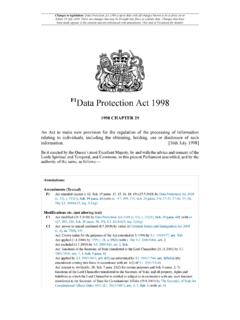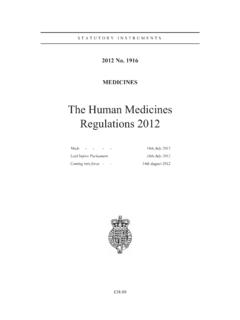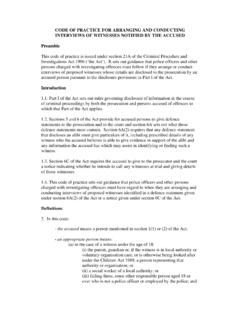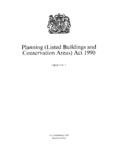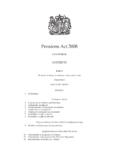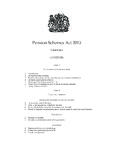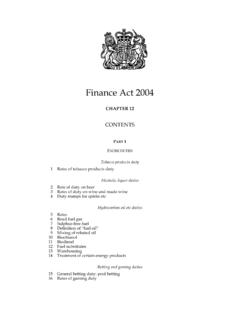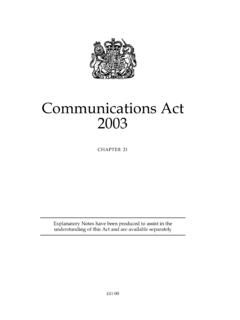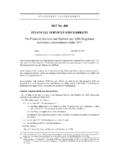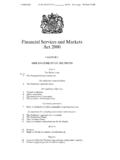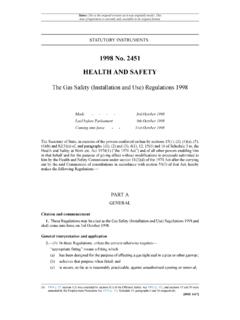Transcription of 2002 No. 2776 HEALTH AND SAFETY - Legislation.gov.uk
1 STATUTORY INSTRUMENTS2002 No. 2776 HEALTH AND SAFETYThe Dangerous Substances and Explosive AtmospheresRegulations 2002 made - - - - -7th November 2002 Laid before Parliament15th November 2002 Coming into force - -All regulations except forregulations 5(4)(c), 7, 11,15(2), 16(2) and 17(1) to(3)9th December 2002 Regulations 15(2) and 16(2)5th May 2003 Regulations 5(4)(c), 7, 11 and17(1) to (3)30th June 2003 ARRANGEMENT OF REGULATIONS1. Citation and Duties under these Risk Elimination or reduction of risks from dangerous Places where explosive atmospheres may Arrangements to deal with accidents, incidents and Information, instruction and Identification of hazardous contents of containers and Duty of Extension outside Great Exemption Exemptions for Ministry of Defence Repeals and Transitional 1.
2 General SAFETY 2. Classification of places where explosive atmospheres may 3. Criteria for the selection of equipment and protective 4. Warning sign for places where explosive atmospheres may 5. Legislation concerned with the marking of containers and Repeal and Repeal and Secretary of State in exercise of the powers conferred on him by sections 15(1), (2), (3)(a)and (5), 80(1) and 82(3)(a) of, and paragraphs 1(1), (2) and (4), 6, 9, 11, 14, 16, 18(b) and 20 ofSchedule 3 to, the HEALTH and SAFETY at Work etc. Act 1974(a) ( the 1974 Act ) and of all otherpowers enabling him in that behalf and for the purpose of giving eVect without modificationsto proposals submitted to him by the HEALTH and SAFETY Commission under section 11(2)(d) ofthe 1974 Act after the carrying out by the said Commission of consultations in accordance withsection 50(3) of that Act, hereby makes the following Regulations.
3 Citation and Regulations may be cited as the Dangerous Substances and ExplosiveAtmospheres Regulations 2002 and shall come into force (a) as respects all regulations except for regulations 5(4)(c), 7, 11, 15(2), 16(2) and 17(1)to (3) on 9th December 2002;(b) as respects regulations 15(2) and 16(2) on 5th May 2003; and(c) as respects regulations 5(4)(c), 7, 11 and 17(1) to (3) on 30th June these Regulations approved classification and labelling guide means the Approved Guide to theClassification and Labelling of Dangerous Substances and Dangerous Preparations (5thedition)(b) approved by the HEALTH and SAFETY Commission on 16th April 2002; the CHIP Regulations means the Chemicals (Hazard Information and Packaging forSupply) Regulations 2002(c).
4 Dangerous substance means (a) a substance or preparation which meets the criteria in the approved classificationand labelling guide for classification as a substance or preparation which isexplosive, oxidising, extremely flammable, highly flammable or flammable,whether or not that substance or preparation is classified under the CHIPR egulations;(b) a substance or preparation which because of its physico-chemical or chemicalproperties and the way it is used or is present at the workplace creates a risk, notbeing a substance or preparation falling within subparagraph (a) above; or(c) any dust, whether in the form of solid particles or fibrous materials or otherwise,which can form an explosive mixture with air or an explosive atmosphere, notbeing a substance or preparation falling within subparagraphs (a) or (b) above; explosive atmosphere means a mixture, under atmospheric conditions, of air and oneor more dangerous substances in the form of gases, vapours, mists or dusts in which, afterignition has occurred, combustion spreads to the entire unburned mixture.
5 Hazard means the physico-chemical or chemical property of a dangerous substancewhich has the potential to give rise to fire, explosion, or other events which can result inharmful physical eVects of a kind similar to those which can be caused by fire or explosion,aVecting the SAFETY of a person, and references in these Regulations to hazardous shallbe construed accordingly;a)( 1974 c. 37; section 15(1), 50(3) and 52 were amended by the Employment Protection Act 1975 (c. 71), Schedule 15,paragraphs 6, 16(3) and 17 respectively; section 51A was added and section 52 was amended by the Police ( HEALTH andSafety) Act 1997 (c.)
6 42), sections 1 and 2 respectively; the general purposes of Part 1 of the 1974 Act were extended bythe OVshore SAFETY Act 1992 (c. 15), section 1(1).b)( ISBN )( 2002 oVshore installation has the same meaning as it is given by regulation 3 of the OVshoreInstallations and Pipeline Works (Management and Administration) Regulations 1995(a)insofar as that regulation extends to mineral extracting industries within the scope ofArticle 2(a) of Council Directive 92/91/EEC concerning the minimum requirements forimproving the SAFETY and HEALTH protection of workers in the mineral-extracting industriesthrough drilling(b).
7 Personal protective equipment means all equipment which is intended to be worn orheld by a person at work and which protects that person against one or more risks to hissafety, and any addition or accessory designed to meet that objective; preparation means a mixture or solution of two or more substances; public road means (in England and Wales) a highway maintainable at public expensewithin the meaning of section 329 of the Highways Act 1980(c) and (in Scotland) a publicroad within the meaning assigned to that term by section 151 of the Roads (Scotland)Act 1984(d); risk means the likelihood of a person s SAFETY being aVected by harmful physical eVectsbeing caused to him from fire, explosion or other events arising from the hazardousproperties of a dangerous substance in connection with work and also the extent of thatharm; risk assessment means the assessment of risks required by regulation 5(1); SAFETY data sheet means a SAFETY data sheet within the meaning of regulation 5 of theCHIP Regulations; substance means any natural or artificial substance whether in solid or liquid form orin the form of a gas or vapour.
8 Workplace means any premises or part of premises used for or in connection with work,and includes (a) any place within the premises to which an employee has access while at work; and(b) any room, lobby, corridor, staircase, road or other place (i) used as a means of access to or egress from that place of work, or,(ii) where facilities are provided for use in connection with that place of work,other than a public road; and work processes means all technical aspects of work involving dangerous substances andincludes (a) appropriate technical means of supervision,(b) connecting devices,(c) control and protection systems,(d) engineering controls and solutions,(e) equipment,(f) materials,(g) machinery,(h) plant,(i) protective systems, and(j) warning and other communication (1) These Regulations, apart from regulations 15, 16 and 17(4) to (5)
9 , shall not apply tothe master or crew of a ship or to the employer of such persons in respect of the normal ship-board activities of a ship s crew which are carried out solely by the crew under the direction ofthe master and, for the purposes of this paragraph (a) ship includes every description of vessel used in navigation, other than a shipforming part of Her Majesty s Navy or an oVshore installation; and(b) the reference to the normal ship-board activities of a ship s crew includes a)( 1995 )( OJ No. L348, , p. )( 1980 c. )( 1984 c. (i) the construction, reconstruction or conversion of a ship outside, but not inside,Great Britain; and(ii) the repair of a ship save repair when carried out in dry dock.
10 (2) Regulations 5(4)(c), 7 and 11 shall not apply to (a) areas used directly for and during the medical treatment of patients;(b) the use of gas appliances burning gaseous fuel (that is to say, any fuel which is in agaseous state at a temperature of 15)C under a pressure of 1 bar) which (i) are used for cooking, heating, hot water production, refrigeration, lighting orwashing; and(ii) have, where applicable, a normal water temperature not exceeding 105)Cincluding forced draught burners and heating bodies to be equipped with suchburners but not including an appliance specifically designed for use in an industrialprocess carried out on industrial premises;(c) gas fittings within the meaning of the Gas SAFETY (Installation and Use) Regulations1998(a) located in domestic premises, not being gas appliances falling withinsubparagraph (b);(d) the manufacture, handling, use, storage and transport of explosives or chemicallyunstable substances.
